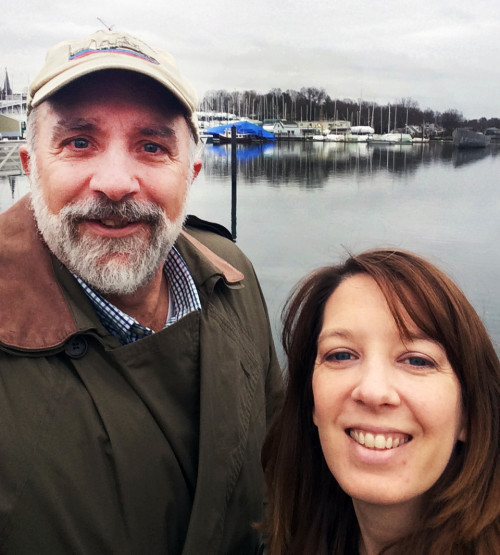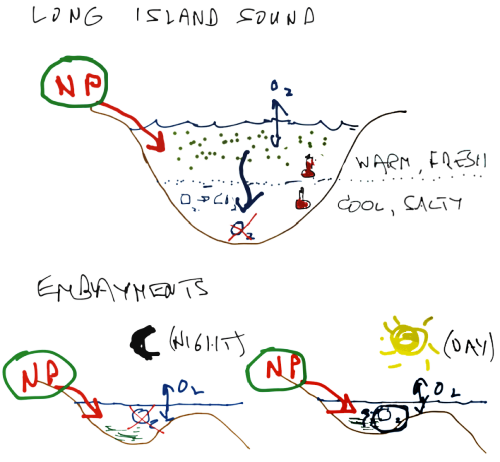Developing a strategy for Long Island Sound embayment report cards
Bill Dennison ·Caroline Donovan and I traveled to Mamaroneck, NY and Stamford, CT on 3 Feb 2016 to work with Save The Sound in developing a strategy for Long Island Sound report cards. The Integration and Application Network produced a Long Island Sound report card in 2015, working with the Long Island Sound Funders Collaborative. In addition, IAN worked with the Hempstead Harbor Protection Committee and the Coalition to Save Hempstead Harbor to produce the Inner Hempstead Harbor report card and with Harbor Watch and Earthplace to produce the Norwalk Harbor report card. In 2016, the Long Island report card will be produced again using 2015 data, and it will be the primary responsibility of Save The Sound, a nonprofit organization based in Mamaroneck, NY. In addition, a strategy for developing embayment report cards will be developed. From our efforts in developing the 2015 report cards, we learned that an overall strategy needs to be developed for embayment report cards, with appropriate guidance to the various citizen science groups around Long Island Sound.

The purpose of this workshop was to nominate appropriate indicators for embayment monitoring in preparation for a March 2016 workshop with the various embayment groups. We met at the Save The Sound office in the morning to discuss the Long Island Sound report card process. Mamaroneck, NY was a cute historic town right on the water, and we could see both Long Island Sound and Long Island. In the afternoon, we met at the Long Island Sound Study office in Stamford, CT.
Jamie Vaudrey from the University of Connecticut presented some of her embayment findings and made some excellent recommendations for embayment groups. Jamie has been investigating dissolved oxygen problems in shallow waters within embayments. She explained how the dissolved oxygen issue in the open waters of western portions of Long Island Sound and the Narrows differs from the dissolved oxygen issue within embayments. In open waters, hypoxia (low oxygen) and anoxia (no oxygen) occurs in the cooler, saltier bottom waters that are effectively cut off from surface re-aeration and the bacterial respiration that occurs when decomposing single celled algae (phytoplankton) settle into bottom waters from the surface consumes oxygen. The resulting hypoxia/anoxia is chronic in summer months. In contrast, the very shallow embayment waters have ample dissolved oxygen, and sometimes are even supersaturated with oxygen, during the day. However, at night, oxygen consumption by both plant and bacterial respiration can be so rapid that re-aeration, even in shallow well mixed water columns cannot keep pace.

Due to the different dissolved oxygen processes in stratified open waters vs. shallow embayment waters, different sampling strategies must be used. In open waters, the chronic hypoxia/anoxia conditions can be sampled day or night. In embayments, hypoxia/anoxia conditions can only be observed at night, so sampling with recording loggers or very early in the morning is necessary. Jamie Vaudrey has been experimenting with inexpensive HOBO® oxygen sensors and loggers, deployed mostly on docks and piers.
Another difference between Long Island Sound open waters and the embayments is the relative dominance of primary producers. In Long Island Sound, it is the single-celled, free-floating phytoplankton that need to be quantified, which traditionally is done by measuring the ubiquitous photosynthetic pigment chlorophyll a. In the embayments, the shallow water allows benthic plants to thrive. Historically, this was largely eelgrass (Zostera marina), a rooted flowering plant. Eelgrass has been largely lost from Long Island Sound, with remnant populations occurring in Eastern Long Island Sound. The major primary producers in embayments are various species of macroalgae, which typically drift around or are loosely attached. Macroalgae are notoriously difficult to quantify. By day, macroalgae photosynthesize and large accumulations of macroalgae can lead to supersaturation of dissolved oxygen. The other primary producer in shallow water are microscopic benthic microalgae (BMA), also known as microphytobenthos. These are even more difficult to quantify and are rarely considered in monitoring programs. We discussed various approaches to assess macroalgae, including using rakes or fishing trawls to collect the algae and then using buckets to measure their volume.

We also discussed measuring nutrients in embayments, with a focus on sampling at the point at which the freshwater inputs enter the estuary. Total nitrogen and total phosphorus were recommended to correspond to the Long Island Sound report card and to avoid sampling variability associated with measuring dissolved nutrients. Water clarity using Secchi disc depth was also recommended. For shallow embayment waters, a Secchi tube, like that developed for tributary groups in Chesapeake Bay can be used to avoid the problem of having the Secchi disc hit the bottom while it was still visible.
We are glad that the Long Island Sound report card process is forging ahead and that we have the opportunity to assist Save The Sound. It was gratifying to learn that the 2015 report card helped catalyze the recently released Long Island Nutrient Action Plan. Maintaining this momentum will be crucial for the restoration of Long Island Sound.

As a workshop summary, I adapted Billy Joel's New York State of Mind:
Long Island Sound State of Mind
3 Feb 2016
Billy Dennison
Some folks like to get away
Take a holiday from the neighborhood
Hop a flight to Miami Beach or Hollywood
But I'm takin' a train on the LIRR or Metro North
I'm in a Long Island Sound state of mind.
I've seen all the scientists
In their little cars and their laptop computers
Been deep into the data all throughout the Sound
I know what I'm needin', and I don't want to waste time
I'm in a Long Island Sound state of mind.
It was so easy staying out in the Sound
Out of touch with the important embayments
But now we need a little give and take
Adding the embayments to the Sound reporting
Whoa, whoa, whoa
It comes down to sampling reality
And it's fine with me 'cause we can't do it all
I don't care if it's seagrass or macroalgae
I do have some reasons
That I left some indicators behind
I'm in a Long Island Sound state of mind.
Oh yeah.
About the author
Bill Dennison

Dr. Bill Dennison is a Professor of Marine Science and Vice President for Science Application at the University of Maryland Center for Environmental Science.